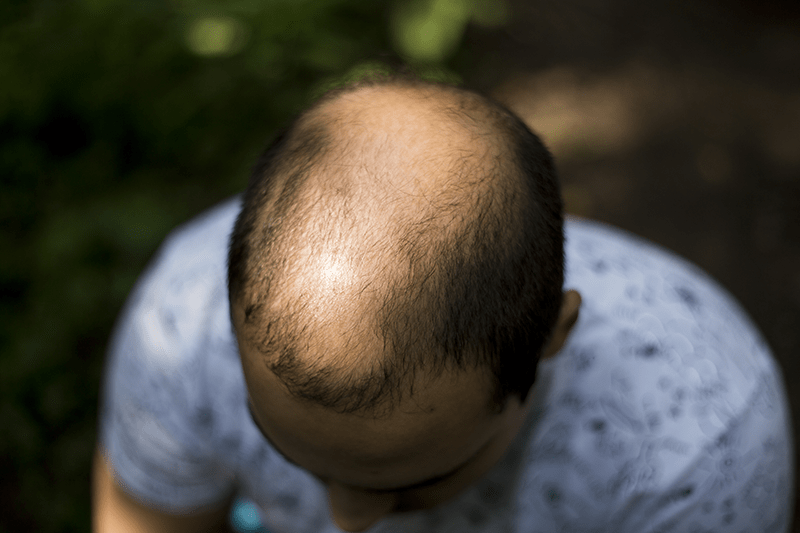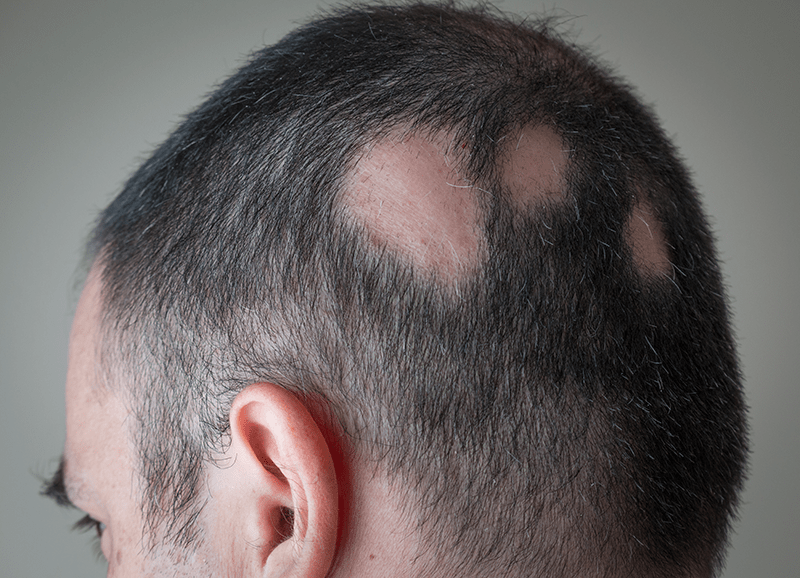Alopecia – hair loss – can have different causes and manifest itself in different ways. A certain amount of hair loss is normal: we all lose around 70 to 100 hairs a day, and these usually grow back. But if they stop growing back, or if the hair loss keeps getting worse, it usually becomes irreversible and progressive. In men and women, alopecia usually manifests itself in different ways. Whilst alopecia in men often begins with a receding hairline or a bald forehead, women’s hair usually starts to thin diffusely on the top of the head. Below, we explain the different types of hair loss.
Androgenetic alopecia – hereditary hair loss
Around 50 to 80 percent of all men are affected by androgenetic alopecia. 40% of women are affected. The cause of androgenetic alopecia lies in the male sex hormone dihydrotestosterone (DHT), which is formed from the hormone testosterone. In hereditary alopecia the hair roots are hypersensitive to DHT, meaning that the hair gradually thins and is slow to grow back. Eventually the hair falls out completely.
- In men, the hair loss usually begins on the forehead and takes the form of a receding hairline. This is followed by a bald patch towards the back of the head – the so-called tonsure. This spreads out until eventually only a ring of hair is left, and we see the typical bald head.
- In women, on the other hand, the hair starts thinning mainly on the top of the head. Bald patches are rare, however.
In men, alopecia often begins between 20 and 50 years of age, whereas it usually emerges in women after the menopause. It can occur earlier, however, due to genetic factors or hormonal changes (after giving birth, for example). Its progression varies from person to person and is impossible to predict.
Alopecia areata – circular hair loss
Alopecia areata, also known as circular hair loss, is easily distinguishable from androgenetic alopecia. All the hair in the affected area falls out, leaving behind a clearly defined bald patch. This form of alopecia is caused by an autoimmune condition which leads the body to attack and destroy its own hair roots. Sometimes the hair grows back as stubble, but often the patches stay bald. Alopecia areata can affect the head, the beard and other parts of the body.
General thinning of the hair: a sign of diffuse alopecia
With diffuse alopecia, the hair loss is not so clearly defined as with circular hair loss. The hair gets sparser and looks thinner, and the skin of the scalp shows through. Then, if the alopecia progresses further, bald patches appear. In women it is harder to distinguish this type of hair loss from androgenetic alopecia, since the presentation is very similar. Diffuse alopecia can occur temporarily as a symptom of an illness or a nutrient deficiency. If the cause is eliminated, the hair loss can be stopped. If there’s a genetic factor at play, however, it is unlikely that the hair loss can be reversed.
Remember, whichever form of hair loss you are affected by, it’s a good idea to see a doctor, who can help you identify the causes and start possible treatments. In most cases, however, alopecia cannot be reversed.
Alopecia can affect the whole body
Alopecia almost always begins on the head. But people with alopecia areata may then experience hair loss all over their body. Alopecia totalis is when all the hair on the head falls out. As well as the hair on their head, people with alopecia totalis may lose their beard, their eyelashes and their eyebrows. Hair loss specifically affecting the beard is called alopecia barbae. If the alopecia progresses further, it can turn into alopecia universalis, which is when all the hair on the body falls out.
How does alopecia affect people?
For most people, hair loss is a major source of psychological distress. But you don’t have to put up with bald patches on your scalp. One good solution is scalp micropigmentation, which can either hide bald patches or make your hair look thicker.
Do you want to do something about your alopecia?
Then get in touch! We’ll be happy to tell you anything you’d like to know about scalp micropigmentation!

